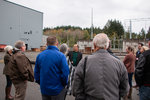









Around 30 officials from the Centralia city government and other local entities attended a presentation hosted by Zap Energy, TransAlta and the Centralia Coal Transition Board this week to assess the feasibility of putting a Zap Energy fusion pilot plant at the site of the TransAlta Big Hanaford Road gas power plant.
The meeting came as the company is determining whether it can retrofit part of the TransAlta plant. TransAlta is set to shut down its coal-fired operations in 2025 as part of a deal reached with the state well over a decade ago.
Ryan Umstattd, vice president of product for Zap Energy, broke down the details of the fusion process, explaining how in his view it’s different and safer than traditional nuclear energy.
Traditional nuclear energy relies on fission, the process of breaking apart very heavy atoms such as uranium or plutonium to release energy. Fusion relies on breaking apart the lightest atom, hydrogen.
“There’s no long-term radioactive waste. It’s safe in that it’s vastly different from traditional nuclear power plants. There’s no possibility of a runaway reaction,” Umstattd said.
The process uses two hydrogen isotopes, deuterium and tritium. Both isotopes are ionized so the fusion process revolves around using an electrical pulse to force the isotopes to combine in a plasma chamber, creating a helium atom and neutron, which are the fusion particles.
Particles created by fusion give off extra energy in the form of heat, which is captured by a liquid metal blanket of lead and lithium. The heat from that liquid metal blanket can be used to drive a steam cycle like in both traditional nuclear fission plants and coal powered plants.
Umstattd added that runaway reactions aren’t a risk because a fusion reaction relies on an outside source of energy to start the reaction and the reaction stops if the power source is removed, as opposed to the dangers of fission, a process in which a chain reaction can set off a runaway reaction resulting in a catastrophic reactor meltdown. With fusion, there is absolutely no possibility of a nuclear meltdown.
“For us to even get to fusion reactions, you have to add a lot of energy to the fuel, you have to drive it with the electrical pulse. If the power goes out and I can no longer drive it, the plasma just relaxes back into hydrogen gas,” Umstattd said.
Additionally, the half-life of both tritium and deuterium is just over 12 years, which is minimal compared to half-lives of some uranium isotopes which, can be millions to billions of years. The amounts of tritium and deuterium needed to maintain a fusion reaction are also substantially less than the amounts of fuel fission reactors need.
Umstattd stated the heat core will have lead shielding to protect workers and also trap as much heat energy as possible to convert it into usable electricity.
He claimed that the electricity created from Zap’s fusion reactors would cost customers between four and six cents per kilowatt-hour (kWh) as the wholesale price. Currently, Centralia citizens pay on average between seven and eight cents per kWh depending whether they’re within city limits or not.
Zap Energy is still only looking into the feasibility of the site and ensuring that the pilot plant will fit in the space available and determining if they can utilize any of the existing infrastructure.
According to Umstattd, if the site is chosen, he expects Zap’s fusion pilot plant to be operational by 2030.
One major roadblock Umstattd mentioned is the U.S. Nuclear Regulatory Commission (NRC). He said the commission is the main reason why this plant will be a pilot plant.
The purpose of the pilot plant will be to see if they can supply at least 50 megawatts of power off of the one fusion reactor. Zap will be running tests that will require them to shut down and restart as well.
“I can’t guarantee that even if we knock it out of the park on the science and engineering, I can’t guarantee that we’ll be allowed to commercialize it yet. The NRC has said they are going to regulate commercial fusion energy, so while I can build a pilot, I may not be able to generate revenue from it until we get the NRC’s blessing,” Umstattd said.
He added that the NRC has been working with the fusion industry more in the past few years.
Umstattd stated that Zap does have almost 90 employees working on completing their and has raised over $200 million in venture capital. He said Chevron is also an investor. Their research and development team
Centralia City Light General Manager M.L. Norton was one of the city officials who attended the presentation. He stated that at least within the city’s government, the general consensus was in favor of fusion power.
“I have spoken to several people in my circle at the City of Centralia and Centralia City Light and no real concerns were expressed regarding fusion power. There was widespread agreement that it would benefit the local and county economy and education system in a tremendous way,” Norton said.
He also believes the price point Umstattd pitched was attainable.
“The claim of four to six cents per kWh power would put fusion power nearly on a par with the hydropower supplied by the dams on the Columbia and Snake Rivers. I have no reason to doubt his claim at this point in time,” Norton said.
Norton said he was overall impressed by the presentation as well as the employment opportunities it would bring. He said it could provide internship opportunities to Centralia College and give the local economy a boost. He added that Zap isn’t the only company looking at using the Big Hanaford plant as a location for a new power generating system.
“The TransAlta site has also been under consideration for the placement of a small modular reactor. This would use fission to make power, similar to the Columbia Generating Station located on the Hanford Reservation near the Tri-Cities,” Norton said.
Should Zap Energy actually move ahead with their plans to build the pilot plant here in Centralia, it would be the first fusion plant of its kind.
For more information on Zap Energy and their fusion plants, visit https://www.zapenergyinc.com/.